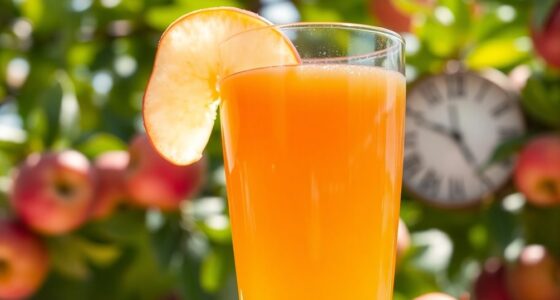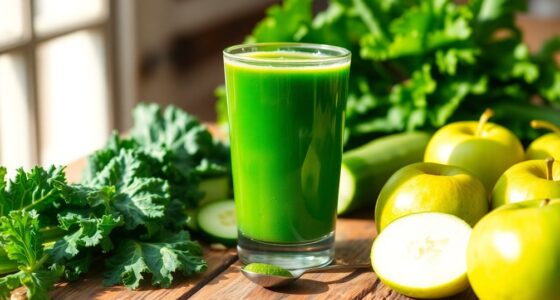Elf Bars come in various models, each with different e-liquid capacities. The Elf Bar 600 holds 2ml, while the AF5000 has 10ml. If you're looking for a larger option, the BC5000 features a generous 15ml reservoir. These capacities impact how many puffs you can get before needing a replacement, catering to your vaping needs. Curious about which model might suit you best? There's more to explore about these versatile devices!
Key Takeaways
- The Elf Bar AF5000 contains 10ml of e-liquid capacity.
- The Elf Bar BC5000 features a larger 15ml e-liquid reservoir.
- The Elf Bar 600 has a smaller capacity of 2ml.
- E-liquid capacity directly impacts the number of puffs available.
- Most Elf Bars typically have a nicotine strength of 20mg/ml.

Have you ever wondered how much juice is in an Elf Bar? If you're considering diving into the world of disposable vapes, knowing the e-liquid capacity of these devices can significantly influence your vaping experience. Elf Bars come in various models, each designed to cater to different preferences, and their e-liquid reservoirs vary accordingly.
For instance, the Elf Bar AF5000 features a generous 10ml e-liquid capacity, which means you can enjoy a significant number of puffs before running low on juice. This model is perfect for those who want a longer-lasting device that doesn't require frequent replacements.
On the other hand, the Elf Bar BC5000 takes it a step further with a slightly larger 15ml reservoir, providing approximately 5000 puffs. This makes it ideal for vapers who are looking for a reliable and extended vaping experience without the hassle of changing devices too often.
If you're looking for something more compact, the popular Elf Bar 600 model has a smaller e-liquid capacity of 2ml, which corresponds to roughly 600 puffs. While this might seem limited compared to the larger models, it's a great option for those who prefer a lighter device or are just starting their vaping journey.
Regardless of which Elf Bar model you choose, each is designed with a specific e-liquid capacity that complies with TPD regulations in the UK, ensuring quality and safety.
When it comes to the e-liquids themselves, most Elf Bars typically have a nicotine strength of 20mg/ml. This strength is quite popular among vapers, especially those transitioning from traditional cigarettes, because it provides a satisfying hit without overwhelming the senses.
The use of nicotine salts in these devices enhances the vaping experience, offering a smoother inhale and allowing you to enjoy your favorite flavors without the harshness that sometimes comes with regular nicotine.
Understanding the e-liquid capacity and the number of puffs you can get from an Elf Bar is crucial. After all, you want to get the most out of your vaping experience.
The combination of nicotine salts and the varying e-liquid reservoirs across different Elf Bar models allows you to tailor your vaping experience to your preferences. Whether you opt for a high-capacity model or a more compact one, you can find an option that fits your lifestyle.
Frequently Asked Questions
How Much Liquid Does the Elf Bar BC5000 Hold?
The Elf Bar BC5000 holds 15 mL of e-liquid, giving you a substantial amount to enjoy during your vaping sessions.
With this capacity, you can expect around 5000 puffs, depending on how often you vape. It uses 50 mg nicotine salt juice, so you'll get a strong nicotine hit.
Plus, its design minimizes leakage and allows for easy recharging, ensuring you make the most of every drop before it's time to replace the device.
Can You Refill 5k Elf Bars?
You can't refill 5k Elf Bars.
These devices are designed as disposable vapes, so once the e-liquid runs out, it's meant to be replaced, not refilled.
Trying to refill them can damage the device and cause leaks or malfunctions.
It's best to purchase a new one when your current vape is empty.
Stick to the intended use to ensure a safe and enjoyable vaping experience.
How Long Does a BC5000 Elf Bar Last?
The BC5000 Elf Bar can last you a whole day with moderate use, thanks to its design for around 5000 puffs.
Your experience may vary depending on how often you vape, but most find it reliable for extended sessions.
You might need to recharge it a few times before the e-liquid runs out, but that Type-C charging takes only about an hour, making it easy to keep going throughout your day. Additionally, the convenient charging process allows you to enjoy your favorite flavors without interruption, fitting seamlessly into your busy schedule. Just like wondering how long can beet juice last in your fridge, it’s essential to stay prepared and make the most of your e-liquid experience. With such quick recharge times, you’ll never have to worry about running out of power when you need it the most.
How Many Ml of Juice Is in a Disposable Vape?
When you consider disposable vapes, their juice capacity typically ranges from 2ml to 15ml, depending on the model.
Smaller devices usually hold around 2ml, while larger ones can contain up to 15ml.
This e-liquid volume directly affects how long you can use the vape before it runs out, with higher capacities providing more puffs.
Conclusion
So, when you're enjoying your Elf Bar, you're likely getting around 2ml to 5ml of juice, depending on the model you choose. Isn't it great to know what you're vaping? Understanding how much juice you're consuming can really enhance your experience. Next time you reach for an Elf Bar, you'll have a better idea of what to expect. Why not savor every puff and appreciate the flavor packed in that little device? Enjoy!
Cindy thoroughly researches juicing trends, techniques, and recipes to provide readers with practical advice and inspiration. Her writing style is accessible, engaging, and designed to make complex concepts easy to understand. Cindy’s dedication to promoting the advantages of juicing shines through her work, empowering readers to make positive changes in their lives through the simple act of juicing.











